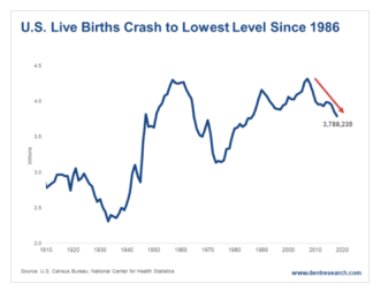The Centers for Disease Control and Prevention announced that the number of American live births dropped to 3,788,235 in 2018. That’s a 2% drop from 2017, and a 12% drop from the 2007 high. It puts us back at levels last seen in 1986.
But the numbers look worse when you drill down.

The population today is around 330 million. It was around 240 million in 1986. So, we’re producing the same number of babies despite having a population nearly 40% larger.
Replacement Rate
Our birth rate is now approximately 1.7 children born per woman, which is well below the replacement rate of 2.1. We still have a steady flow of immigration, and immigrants tend to be relatively young.
They help balance out the workforce with lower birth rates. But unless something changes — which is difficult given that the largest cohort of Millennial women are aging out of peak childbearing years — we’re looking at a lost generation.
Young Adults
We could blame student debt or the high cost of housing. We could blame the low starting salaries for young people, or a college educational system that produces graduates without much in the way of technical skills. We could blame smartphones, the addiction to social media, and the change in day-to-day communication and relationships.

Whatever the reason is, the result is that Millennials do have a distinct lack of mojo. Various studies have shown that Millennials have less sex and with fewer partners than Gen X or the Baby Boomers did at similar ages.
Childless Japan
And this isn’t just an American phenomenon. Japan is essentially becoming asexual at this point. A recent study found that 70% of unmarried men and 60% of unmarried women aged 18-34 were not in a relationship, and over 40% in that age group had never had sex at all.
The world seems to be losing its animal spirits, and we’re going to feel the impacts.
Rodney Johnson wrote about this Economy & Markets, focusing on the effects it has on workforce growth and government funding. And he’s right. A social welfare system needs a steady supply of young people to support the elderly in retirement, and businesses need young workers.
Waning Consumers
But of all the consequences of a low birthrate, I’m least concerned about labor. Our economy has been replacing workers with machines for my entire lifetime.
I’m far more concerned with who’s going to be swiping the credit cards of the future.
Ever since the dawn of the Industrial Revolution, the economy has been an exercise in producing more goods and services for more people. Whether we’re talking about cars, houses, simple jeans or complex iPhones, the story is the same: an ever-growing population consumes a growing production of “stuff.”
Economic Drag
But what happens when the population stops growing? There’s not much point in building new homes or offices if there are fewer people to put in them. Where do new flat screen TVs go if there are no new walls to hang them on?
In my opinion, at some point, the economy starts to look like an enormous Ponzi scheme that needs a continuous flow of new people to keep it afloat.
Now, I’m not one for all the doom and gloom. And I’m not predicting any kind of zombie apocalypse. Life will go on. But it’s not going to be the kind of economy we grew up in.
Takeaway
It’s going to be an economy with slower growth, one with much less dynamic, and will likely resemble economies like Japan or Europe rather than a “traditional” America economy. One that will be marked by chronically low inflation and even occasional bouts of deflation.
It’ll be an economy that favors a different kind of investing. One where income strategies will thrive and growth will fail. With periods of slow inflation and low growth, a steady stream of cash is a lot more attractive than times of fast revenue and earnings.
Photo Credit: mulan via Flickr Creative Commons
Disclaimer: This material is provided for informational purposes only, as of the date hereof, and is subject to change without notice. This material may not be suitable for all investors and is not intended to be an offer, or the solicitation of any offer, to buy or sell any securities nor is it intended to be investment advice. You should speak to a financial advisor before attempting to implement any of the strategies discussed in this material. There is risk in any investment in traded securities, and all investment strategies discussed in this material have the possibility of loss. Past performance is no guarantee of future results. The author of the material or a related party will often have an interest in the securities discussed. Please see Full Disclaimer for a full disclaimer.
Certain of the information contained in this article is based upon forward-looking statements, information and opinions, including descriptions of anticipated market changes and expectations of future activity. The author believes that such statements, information, and opinions are based upon reasonable estimates and assumptions. However, forward-looking statements, information and opinions are inherently uncertain and actual events or results may differ materially from those reflected in the forward-looking statements. Therefore, undue reliance should not be placed on such forward-looking statements, information and opinions.

